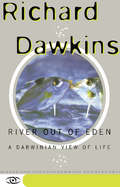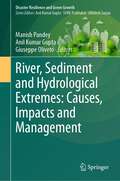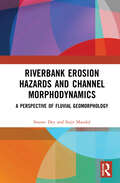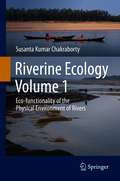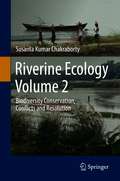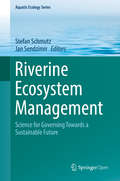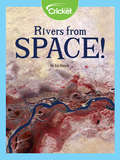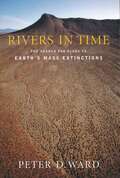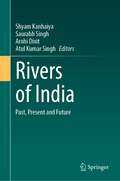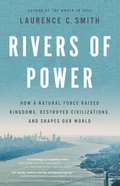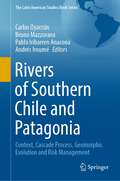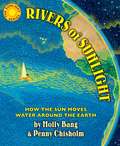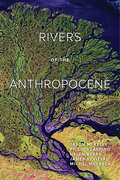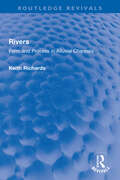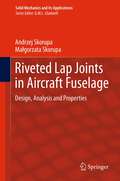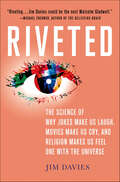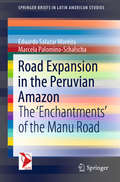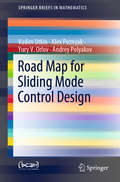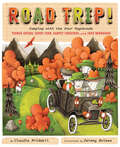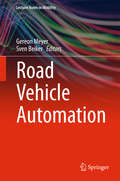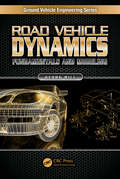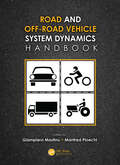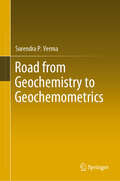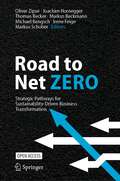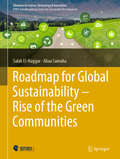- Table View
- List View
River out of Eden: A Darwinian View of Life
by Richard DawkinsHow did the replication bomb we call ”life” begin and where in the world, or rather, in the universe, is it heading? Writing with characteristic wit and an ability to clarify complex phenomena (the New York Times described his style as ”the sort of science writing that makes the reader feel like a genius”), Richard Dawkins confronts this ancient mystery.
River, Sediment and Hydrological Extremes: Causes, Impacts and Management (Disaster Resilience and Green Growth)
by Anil Kumar Gupta Manish Pandey Giuseppe OlivetoThis edited book provides a platform for knowledge sharing in all areas related to the rivers, sediment and hydrological extremes. It explains the hypothesis that river flow and sediment transport are intimately linked to erosion, scour and sediment deposition. Sediment transport, erosion and deposition are driven by local base-level changes and are highly variable in space and time. These concepts have serious implication for understanding the recent development of the River, Sediment and Hydrological Extremes.The natural hazards posed by hydrologic events and river systems depend on the uncertainty of hydrological events. This ability is affected by change in climatic conditions. Climate change studies have revealed that the frequency of extreme weather phenomena with increasing damage to human assets has gradually grown worldwide. As a consequence, rainfall events concentrated in time and space are expected to lead to serious local flooding and sediment transport in many parts of the world. Floods are remarkable hydro-meteorological phenomena and forceful agents of geomorphic evolution in most physical geographical belts and, from the viewpoint of human society, among the most important environmental hazards. According to the Indian Environment Agency, floods rank as number one on the list of natural disasters in India over the past decade.This book is an attempt to fill the gap in literature and bring forth evidence based latest research about precise estimation of erosion and scour, which is essential to reduce the hazards. The book explains that lack of preparedness and appropriate adaptation strategy makes people more risk-prone. It highlights the vulnerability in South Asia region about the impacts of flood, sediments, and river hazards because a large portion of its population depends on sensitive sectors like agriculture and forestry for livelihoods and several other reasons.The book is relevant for academician, researchers and students of disaster management, hydrology and ecology.
Riverbank Erosion Hazards and Channel Morphodynamics: A Perspective of Fluvial Geomorphology
by Sujit Mandal Sourav DeyThis book explores fluvial processes and their consequences on river dynamics in India. It discusses the integration of geomorphic, hydrologic, and socio-economic data with various policies and decisions regarding sustainable river basin management. The volume looks at the origin and development of streams, chronology of fluvial geomorphology, fluvial system concept, process–form interaction, river dynamics, channel migration, flow regime, channel types, and hydraulic and morphometric parameters; and explains how changing hydro-geomorphological dynamics have influenced land use patterns, nature of fluids, behaviour of floods, etc. It examines channel migration vulnerability and bank erosion hazard vulnerability of the Torsa River in the eastern region of India as a case study using channel migration zone and Bank Erosion Hazard Index models. The book presents a new research framework based on field surveys, scientific investigations, and analytical techniques and methods to interpret key geoinformatics data. With its extensive illustrations, this book will be useful to students, teachers, and researchers of geography, earth sciences, environmental geology, and environment and disaster management. It will also interest geographers, civil engineers, hydrologists, geomorphologists, planners, and other individuals and organizations working on fluvial processes and riverbank erosion problems globally.
Riverine Ecology Volume 1: Eco-functionality of the Physical Environment of Rivers
by Susanta Kumar ChakrabortyThis book is part of a two-volume set that offers an innovative approach towards developing methods and tools for assigning conservation categories of threatened taxa and their conservation strategies by way of different phases of eco-restoration in the context of freshwater river systems of tropical bio-geographic zones. The set provides a considerable volume of research on the biodiversity component of river ecosystems, seasonal dynamics of physical chemical parameters, geo-hydrological properties, types, sources and modes of action of different types of pollution, river restoration strategies and methodologies for the ongoing ecological changes of river ecosystems. Volume 1 provides an in-depth analysis of different theories with international relevance pertaining to the functioning of river ecosystems, shaping their structure and contributing ecological services, and includes the principles of riverine ecology such as biogeochemical cycles, physiography, hydrogeology, and physico-chemical parameters. It covers the basic concepts and principles of water within riverine ecosystems, and the underlying ecological principles operating to ensure ecological stability and sustainability of the fluvial ecosystem. The book explains the ecofunctionality of different geo-morphological, geo-hydrological and physico-chemical factors and processes in changing time scales and spaces, with special emphasis on the tropical fresh water rivers in India.
Riverine Ecology Volume 2: Biodiversity Conservation, Conflicts and Resolution
by Susanta Kumar ChakrabortyThis book is part of a two-volume set that offers an innovative approach towards developing methods and tools for assigning conservation categories of threatened taxa and their conservation strategies by way of different phases of eco-restoration in the context of freshwater river systems of tropical bio-geographic zones. The set provides a considerable volume of research on the biodiversity component of river ecosystems, seasonal dynamics of physical chemical parameters, geo-hydrological properties, types, sources and modes of action of different types of pollution, river restoration strategies and methodologies for the ongoing ecological changes of river ecosystems.Volume 2 highlights biodiversity potential in aiding the resistance and resilience of riverine ecosystem functioning and their synergistic effects on ongoing environmental perturbations. Comprehensive information on the conservation of river-associated-wildlife is provided, covering the impacts of pollution, land-use changes, river policies, and ecosystem restoration strategies. The book offers an innovative approach towards developing methods and tools for assigning conservation categories of threatened taxa, and covers their conservation strategies by way of different phases of eco-restoration in the context of freshwater river systems of tropical bio-geographic zones.
Riverine Ecosystem Management: Science For Governing Towards A Sustainable Future (Aquatic Ecology Series #8)
by Stefan Schmutz Jan SendzimirThis open access book surveys the frontier of scientific river research and provides examples to guide management towards a sustainable future of riverine ecosystems. Principal structures and functions of the biogeosphere of rivers are explained; key threats are identified, and effective solutions for restoration and mitigation are provided. Rivers are among the most threatened ecosystems of the world. They increasingly suffer from pollution, water abstraction, river channelisation and damming. Fundamental knowledge of ecosystem structure and function is necessary to understand how human acitivities interfere with natural processes and which interventions are feasible to rectify this. Modern water legislation strives for sustainable water resource management and protection of important habitats and species. However, decision makers would benefit from more profound understanding of ecosystem degradation processes and of innovative methodologies and tools for efficient mitigation and restoration. The book provides best-practice examples of sustainable river management from on-site studies, European-wide analyses and case studies from other parts of the world. This book will be of interest to researchers in the field of aquatic ecology, river system functioning, conservation and restoration, to postgraduate students, to institutions involved in water management, and to water related industries.
Rivers from Space!
by Liz HuyckWhen on land, rivers, lakes, and oceans appear flat. With the aid of satellites, these bodies of water appear to have many designs! Explore the art of nature and how satellites detect the temperature of the many bodies of water around the globe.
Rivers in Time
by Peter D. WardSeveral times in the distant past, catastrophic extinctions have swept the Earth, causing more than half of all species―from single-celled organisms to awe-inspiring behemoths―to suddenly vanish and be replaced by new life forms. Today the rich diversity of life on the Earth is again in grave danger―and the cause is not a sudden cataclysmic event but rather humankind's devastation of the environment. Is life on our planet teetering on the brink of another mass extinction? In this absorbing new book, acclaimed paleontologist Peter D. Ward answers this daunting question with a resounding yes. Elaborating on and updating Ward's previous work, The End of Evolution, Rivers in Time delves into his newest discoveries. The book presents the gripping tale of the author's investigations into the history of life and death on Earth through a series of expeditions that have brought him ever closer to the truth about mass extinctions, past and future. First describing the three previous mass extinctions―those marking the transition from the Permian to the Triassic periods 245 million years ago, the Triassic to the Jurassic 200 million years ago, and the Cretaceous to the Tertiary 65 million years ago―Ward assesses the present devastation in which countless species are coming to the end of their evolution at the hand of that wandering, potentially destructive force called Homo sapiens. The book takes readers to the Philippine Sea, now eerily empty of life, where only a few decades of catching fish by using dynamite have resulted in eviscerated coral reefs―and a dramatic reduction in the marine life the region can support. Ward travels to Canada's Queen Charlotte Islands to investigate the extinctions that mark the boundary between the Triassic and Jurassic periods. He ventures also into the Karoo desert of southern Africa, where some of Earth's earliest land life emerged from the water and stood poised to develop into mammal form, only to be obliterated during the Permian/Triassic extinction. Rivers of Time provides reason to marvel and mourn, to fear and hope, as it bears stark witness to the urgency of the Earth's present predicament: Ward offers powerful proof that if radical measures are not taken to protect the biodiversity of this planet, much of life as we know it may not survive.
Rivers of India: Past, Present and Future
by Atul Kumar Singh Saurabh Singh Shyam Kanhaiya Arohi DixitThis volume presents geological, geographical, environmental, and agriculture related studies on rivers, focusing on basins of the three geomorphic divisions of India, i.e. peninsular India, Indo-Gangetic plain and extra-peninsular India. The book compiles data on both the small and large river systems of India, the large rivers include Jhelum, Ghaghara, Narmada, Son, Krishna and Godavari; and the small scale, rain-fed and groundwater-fed rivers such as Gomti have been studied. The chapters comprehensively provide assessments of geomorphological aspects, river sediment supply, clean water availability for human population, ground water recharge, flood management and irrigation. The information presented in this book will appeal to students, teachers, researchers and planners engaged in river development, management and conservation.
Rivers of Power: How a Natural Force Raised Kingdoms, Destroyed Civilizations, and Shapes Our World
by Laurence C. SmithAn "eye-opening, sometimes alarming, and ultimately inspiring" natural history of rivers and their complex and ancient relationship with human civilization (Elizabeth Kolbert, Pulitzer Prize-winning author of The Sixth Extinction).Rivers, more than any road, technology, or political leader, have shaped the course of human civilization. They have opened frontiers, founded cities, settled borders, and fed billions. They promote life, forge peace, grant power, and can capriciously destroy everything in their path. Even today, rivers remain a powerful global force -- one that is more critical than ever to our future.In Rivers of Power, geographer Laurence C. Smith explores the timeless yet underappreciated relationship between rivers and civilization as we know it. Rivers are of course important in many practical ways (water supply, transportation, sanitation, etc). But the full breadth of their influence on the way we live is less obvious. Rivers define and transcend international borders, forcing cooperation between nations. Huge volumes of river water are used to produce energy, raw commodities, and food. Wars, politics, and demography are transformed by their devastating floods. The territorial claims of nations, their cultural and economic ties to each other, and the migrations and histories of their peoples trace back to rivers, river valleys, and the topographic divides they carve upon the world. And as climate change, technology, and cities transform our relationship with nature, new opportunities are arising to protect the waters that sustain us.Beautifully told and expansive in scope, Rivers of Power reveals how and why rivers have so profoundly influenced our civilization and examines the importance this vast, arterial power holds for the future of humanity."As fascinating as it is beautifully written."---Jared Diamond, Pulitzer Prize-winning author of Guns, Germs, and Steel, Collapse, and Upheaval
Rivers of Southern Chile and Patagonia: Context, Cascade Process, Geomorphic Evolution and Risk Management (The Latin American Studies Book Series)
by Carlos Oyarzún Bruno Mazzorana Pablo Iribarren Anacona Andrés IrouméThis book provides a comprehensive analysis of the evolution of rivers affected by natural and anthropogenic disturbances in the southern Chile and Patagonia. It presents a detailed description of the rivers affected by climatic extremes, volcanic eruptions, large-wood dynamics and impacts, sediment-laden flows, and Glacier Lake Outburst Floods (GLOFs). Moreover, it contains an in-depth discussion of a variety of topics encompassing the ecosystem function of Pacific Patagonia rivers, the geomorphic signatures of Glacier Lake Outburst Floods (GLOFs) and their impacts within river corridors, as well as the assessment of the associated natural hazards and risks. Further, it provides proposals for public and territorial policies that improve the management and sustainable strategies of the hazards and risks. This book is conceived by leading researchers of the Universidad Austral de Chile and includes contributions by distinguished scholars from around the world. It attracts a wide range of readers, including scientific community, researchers, undergraduate and graduate students, and policy makers from Chile and abroad.
Rivers of Sunlight: How the Sun Moves Water Around the Earth (Sunlight Series #4)
by Molly Bang Penny ChisholmA stunning, accessible explanation of the Earth's water cycle and its global effects. In this brightly illustrated narrative, readers will learn about the constant movement of water as it flows around the Earth and the sun's important role as water changes between liquid, vapor, and ice. From sea to sky, the sun both heats and cools water, ensuring that life can exist on Earth. How does the sun keep ocean currents moving, and lift fresh water from the seas? And what can we do to conserve one of our planet's most precious resources? Perfect for any young reader eager to learn more about his or her world, this is an invaluable addition to any classroom, library, or at-home collection. With stunning artwork and compelling scientific explanation, Bang and Chisholm have brought forth a masterpiece that is critically relevant in this environmentally tumultuous time. The newest book in the award-winning Sunlight Series is an important and beautiful exploration one of our planet's delicate geological cycles, clearly and simply presented for young readers.
Rivers of the Anthropocene
by Jason M. KellyA free ebook version of this title is available through Luminos, University of California Press’s Open Access publishing program. Visit www.luminosoa.org to learn more. This exciting volume presents the work and research of the Rivers of the Anthropocene Network, an international collaborative group of scientists, social scientists, humanists, artists, policy makers, and community organizers working to produce innovative transdisciplinary research on global freshwater systems. In an attempt to bridge disciplinary divides, the essays in this volume address the challenge in studying the intersection of biophysical and human sociocultural systems in the age of the Anthropocene, a new geological epoch of humans' own making. Featuring contributions from authors in a rich diversity of disciplines—from toxicology to archaeology to philosophy—this book is an excellent resource for students and scholars studying both freshwater systems and the Anthropocene.
Rivers: Form and Process in Alluvial Channels (Routledge Revivals)
by Keith RichardsOriginally published in 1982, this book presents a detailed review of alluvial river form and process and integrates the distinct but related approaches of geomorphologists, geologists and engineers to the subject. It outlines the environmental catchment factors that control the development of channel equilibrium and provides a detailed account of the sediment transport processes that represent the physical mechanisms by which channel adjustment occurs. Where possible it evaluates theoretical analyses in the context of the empirical evidence. Rivers should prove a valuable textbook for geomorphology students on advanced undergraduate courses on river behaviour and will also be of interest to students of hydraulics and sedimentology and to those concerned with civil and environmental engineering, river management and channel design, maintenance and management in the water industry
Riveted Lap Joints in Aircraft Fuselage
by Andrzej Skorupa Małgorzata SkorupaFatigue of the pressurized fuselages of transport aircraft is a significant problem all builders and users of aircraft have to cope with for reasons associated with assuring a sufficient lifetime and safety, and formulating adequate inspection procedures. These aspects are all addressed in various formal protocols for creating and maintaining airworthiness, including damage tolerance considerations. In most transport aircraft, fatigue occurs in lap joints, sometimes leading to circumstances that threaten safety in critical ways. The problem of fatigue of lap joints has been considerably enlarged by the goal of extending aircraft lifetimes. Fatigue of riveted lap joints between aluminium alloy sheets, typical of the pressurized aircraft fuselage, is the major topic of the present book. The richly illustrated and well-structured chapters treat subjects such as: structural design solutions and loading conditions for fuselage skin joints; relevance of laboratory test results for simple lap joint specimens to riveted joints in a real structure; effect of various production and design related variables on the riveted joint fatigue behaviour; analytical and experimental results on load transmission in mechanically fastened lap joints; theoretical and experimental analysis of secondary bending and its implications for riveted joint fatigue performance; nucleation and shape development of fatigue cracks in riveted longitudinal lap joints; overview of experimental investigations into the multi-site damage for full scale fuselage panels and riveted lap joint specimens; fatigue crack growth and fatigue life prediction methodology for riveted lap joints; residual strength predictions for riveted lap joints in a fuselage structure. The major issues of each chapter are recapitulated in the last section.
Riveted: The Science of Why Jokes Make Us Laugh, Movies Make Us Cry, and Religion Makes Us Feel One with the Universe
by Jim DaviesWhy do some things pass under the radar of our attention, but other things capture our interest? Why do some religions catch on and others fade away? What makes a story, a movie, or a book riveting? Why do some people keep watching the news even though it makes them anxious?The past 20 years have seen a remarkable flourishing of scientific research into exactly these kinds of questions. Professor Jim Davies' fascinating and highly accessible book, Riveted, reveals the evolutionary underpinnings of why we find things compelling, from art to religion and from sports to superstition. Compelling things fit our minds like keys in the ignition, turning us on and keeping us running, and yet we are often unaware of what makes these "keys" fit. What we like and don't like is almost always determined by subconscious forces, and when we try to consciously predict our own preferences we're often wrong. In one study of speed dating, people were asked what kinds of partners they found attractive. When the results came back, the participants' answers before the exercise had no correlation with who they actually found attractive in person! We are beginning to understand just how much the brain makes our decisions for us: we are rewarded with a rush of pleasure when we detect patterns, as the brain thinks we've discovered something significant; the mind urges us to linger on the news channel or rubberneck an accident in case it might pick up important survival information; it even pushes us to pick up People magazine in order to find out about changes in the social structure.Drawing on work from philosophy, anthropology, religious studies, psychology, economics, computer science, and biology, Davies offers a comprehensive explanation to show that in spite of the differences between the many things that we find compelling, they have similar effects on our minds and brains.
Road Expansion in the Peruvian Amazon: The 'Enchantments' of the Manu Road (SpringerBriefs in Latin American Studies)
by Marcela Palomino-Schalscha Eduardo Salazar MoreiraThis book provides in-depth insights into the construction of the first road to reach riparian communities and the main access point to a national park in the Amazonian rain forest. It is based on an ethnographic investigation in Peru’s Manu Province in the Amazon, which explored diverse local attitudes towards the construction of a road in the overlapping buffer zone of two protected areas: the Manu National Park and the Amarakaeri Communal Reserve. The book reveals the applicability of Harvey and Knox’s concept of ‘enchantments of infrastructure’ in the case of first roads, but also makes accessible wider debates in political ecology such as territoriality and frontier development. The promise of first roads sparks feelings of aspiration and anticipation of the advent of development through speedy travel, economic connectivity and political integration. Yet these developments seldom take shape as expected. The author explores the perspectives, social dynamics and political maneuvers that influence first road building processes in the Amazon, which have applicability to experiences and strategies of road development elsewhere.
Road Map for Sliding Mode Control Design (SpringerBriefs in Mathematics)
by Yury V. Orlov Andrey Polyakov Vadim Utkin Alex PoznyakThis book is devoted to control of finite and infinite dimensional processes with continuous-time and discrete time control, focusing on suppression problems and new methods of adaptation applicable for systems with sliding motions only. Special mathematical methods are needed for all the listed control tasks. These methods are addressed in the initial chapters, with coverage of the definition of the multidimensional sliding modes, the derivation of the differential equations of those motions, and the existence conditions. Subsequent chapters discusses various areas of further research. The book reflects the consensus view of the authors regarding the current status of SMC theory. It is addressed to a broad spectrum of engineers and theoreticians working in diverse areas of control theory and applications. It is well suited for use in graduate and postgraduate courses in such university programs as Electrical Engineering, Control of Nonlinear Systems, and Mechanical Engineering.
Road Trip!: Camping with the Four Vagabonds: Thomas Edison, Henry Ford, Harvey Firestone, and John Burroughs
by Claudia FriddellJoin Thomas Edison, Henry Ford, Harvey Firestone, and John Burroughs on their pioneering camping trips during the early 1900s in this energetic and entertaining nonfiction picture-book adventure.After years of inventing things that other people needed, Thomas Edison and Henry Ford realized there was something they needed—a vacation! So, the famous inventors packed up Ford's Model T and invited their good friends Harvey Firestone and John Burroughs to join them as "the Four Vagabonds" hit America's back roads to enjoy the country's natural beauty, fireside chats, and frolicking fun with friends—all while inspiring future generations to invent camping adventures of their own.&“Buckle yourself in as Claudia Friddell and Jeremy Holmes take you on a fun, creative, and certainly unique road trip with America&’s most famous vagabonds—Thomas Edison, Henry Ford, Harvey Firestone, and John Burroughs. The colorful and spirited illustrations, the stories of the Vagabond&’s bivouacking travels and campsite escapades, and the well-researched bibliography makes Road Trip! a great addition to any child&’s library!&” —Matt Andres, curatorial registrar, Edison and Ford Winter Estates
Road Vehicle Automation (Lecture Notes In Mobility Ser.)
by Gereon Meyer Sven BeikerThis contributed volume covers all relevant aspects of road vehicle automation including societal impacts, legal matters, and technology innovation from the perspectives of a multitude of public and private actors. It is based on an expert workshop organized by the Transportation Research Board at Stanford University in July 2013. The target audience primarily comprises academic researchers, but the book may also be of interest to practitioners and professionals. Higher levels of road vehicle automation are considered beneficial for road safety, energy efficiency, productivity, convenience and social inclusion. The necessary key technologies in the fields of object-recognition systems, data processing and infrastructure communication have been consistently developed over the recent years and are mostly available on the market today. However, there is still a need for substantial research and development, e.g. with interactive maps, data processing, functional safety and the fusion of different data sources. Driven by stakeholders in the IT industry, intensive efforts to accelerate the introduction of road vehicle automation are currently underway.
Road Vehicle Dynamics: Fundamentals and Modeling (Ground Vehicle Engineering)
by Georg RillIn striving for optimal comfort and safety conditions in road vehicles, today's electronically controlled components provide a range of new options. These are developed and tested using computer simulations in software in the loop or hardware in the loop environments-an advancement that requires the modern automotive engineer to be able to build ba
Road and Off-Road Vehicle System Dynamics Handbook
by Manfred Ploechl Giampiero MastinuFeaturing contributions from industry leaders in their respective fields, this volume presents comprehensive, authoritative coverage of all the major issues involved in road vehicle dynamic behavior. It begins with a short history of road and off-road vehicle dynamics followed by thorough, detailed state-of-the-art chapters on modeling, analysis and optimization in vehicle system dynamics, vehicle concepts and aerodynamics, pneumatic tires and contact wheel-road/off-road, modeling vehicle subsystems, vehicle dynamics and active safety, man-vehicle interaction, intelligent vehicle systems, and road accident reconstruction and passive safety.
Road from Geochemistry to Geochemometrics
by Surendra P. VermaThis book highlights major problems in the statistical analysis of compositions that have been known for over a century, as well as the corresponding solutions that have been put forward by specialists over the past 30 years. The basic assumptions of normality or multi-normality are pointed out and methods to test and achieve them are also covered. The conventional major and trace element geochemistry and modeling equations are discussed, and are followed by a more sophisticated multidimensional approach to data handling. The book’s main focus is on the use of statistical techniques to facilitate data interpretation. It also highlights the classification (or nomenclature) and tectonic discrimination aspects for both igneous and sedimentary rocks. The book concludes by discussing computer programs that are helping pave the way from geochemistry to geochemometrics. Written by a leading expert in the area of geochemistry, it offers a valuable guide for students and professionals in the area.
Road to Net Zero: Strategic Pathways for Sustainability-Driven Business Transformation
by Thomas Becker Irene Feige Joachim Hornegger Markus Beckmann Oliver Zipse Michael Bengsch Markus SchoberWith this open access book, delve into the insights of respected leaders from academia and industry as they unravel the intricacies of sustainability-driven business transformation. This meticulously curated edited volume reflects on The Road To Net Zero, underscoring the need for pioneering pathways. Embark on a collaborative learning journey and explore key issues along the road to transformation, such as crafting corporate sustainability strategies, new forms of corporate disclosure, transforming value chains, and harnessing the power of technological innovation. Packed with guiding questions and distilled findings from research, this book is a must-read for all decision-makers, strategists, engaged citizens, educators, and learners committed to driving change and shaping a more sustainable future.
Roadmap for Global Sustainability — Rise of the Green Communities: Rise Of The Green Communities (Advances in Science, Technology & Innovation)
by Salah El-Haggar Aliaa SamahaProgressive increases in consumer demands along with aggressive industrial consumption led the world to proximate resource depletion, weather changes, soil and air degradation and water quality deterioration. We now know that the paradigm of production at the expense of human condition is not sustainable. This book briefly explains how we reached this situation and offers suggestions as to what can be done to overcome it. It invites the best entrepreneurial talent and scientific and technological know-how to develop a sustainable economy around sustainable communities, services, and sectors. A major obstacle previously identified by involved parties was the ability of accommodating for the emerging economic growth without causing harm to the environment, especially with resource depletion. This book provides the solution by creating a need to bring on a new revolution that preserves the rights of next generations to live in a healthy environment This Sustainability Revolution requires the integration of economic, environmental, and social factor as well as the practical aspects of implementing sustainability through green activities, which are discussed throughout the book. In this book, a globalization is proposed that encourages creativity and innovation towards sustainability. With this global sustainability approach (real globalization) both rich and poor will benefit from the global sustainability approach. This will close the gap between rich and poor. Developing countries could reap the benefit of current technology without undergoing many of the growing pains associated with development of these technologies. Governments are able to better work together towards common goals now that there is an advantage in cooperation, an improved ability to interact and coordinate, and a global awareness of issues. The book presents a sustainability roadmap to bring together various concepts, that have been dealt with independently by previous authors, and link them to establish the fundamental practical steps. The flow path and the direction for successful implementation of a sustainability roadmap are also discussed in detail in the book. For the first time, the authors use sustainable communities to create a better quality of life for residents while minimizing the use of the resources to meet current needs and ensure adequate resources for future generations. These green communities create new industries for the local economy and improve public health, which offers more hope for their citizens. Sustainable transportation, renewable energy, recycling, clean water, and urban forests help to make a more livable community and help to control the global climate change. They involve all citizens and incorporate local values into decision-making.
